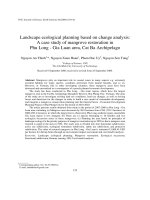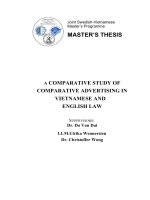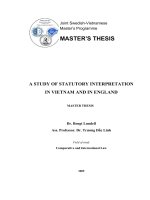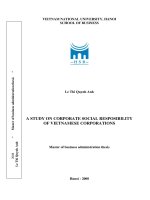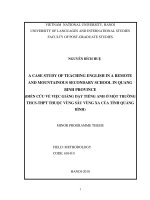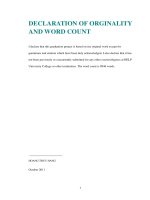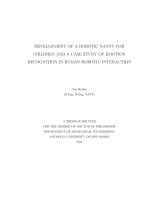A CASE STUDY OF CORPORATE SOCIAL RESPONSIBILITY A SUSTAINABLE TOOL OF COMPANIES’ DEVELOPMENT IN VIETNAM
Bạn đang xem bản rút gọn của tài liệu. Xem và tải ngay bản đầy đủ của tài liệu tại đây (570.85 KB, 61 trang )
1
DECLARATION OF ORGINALITY
AND WORD COUNT
I declare that this graduation project is based on my original work except for
quotations and citation which have been duly acknowledged. I also declare that it has
not been previously or concurrently submitted for any other courses/degrees at HELP
University College or other institutions. The word count is 8946 words.
HOANG THUY HANG
October 2011
2
ACKNOWLEDGEMENT
As to complete this graduation project, I was granted a lot of support, guidance and
assistance from mentors and lecturers. Therefore, I want to thank to all who support,
direct and motivate me during the process of completing the research.
1. First, I would like to express my deep gratitude to my supervisor, Dr.
Pham Duc Hieu from International School at Vietnam National
University, Hanoi who guide me in my choice of assignment
2. I also would like to thank to Ms. Sumathi and Ms. Shenba at Help
University College, who initiated the project and give so much instruction
and support.
3. Thank all the respondents in Panasonic company who have helped me
complete the survey with their enthusiastic and supporting manner.
3
A CASE STUDY OF CORPORATE SOCIAL RESPONSIBILITY: A SUSTAINABLE
TOOL OF COMPANIES’ DEVELOPMENT IN VIETNAM
By
HOANG THUY HANG
October 2011
Supervisor: Dr. PHAM DUC HIEU
ABSTRACT
With the increasing effects of ASEAN over the world, Vietnam is an ideal market for
corporations. Furthermore, becoming the member of WTO since 2007 is an
opportunity as well as the threats for local companies. Following the globalization
trend, corporate social responsibility (CSR) has been the vital issue in both national
and global market. CSR has recently emerged in Vietnam’s market, however, the
knowledge and actions of CSR is limited. Many scandals occurred relating to CSR
issues such as the case of Vedan Co. Ltd, Sabeco Song Lam Co., and Tung Khuang
Co. Ltd. Public now pays more attention to CSR. The objective of the research is to
analyze the relationship between CSR and the company’s stainable development in
the case of Panasonic Vietnam Co. Ltd. From conducting the research, it is able to
show the understanding and awareness about CSR concept, how the company treat
its different layers of stakeholders, CSR implementation process, and give the
conclusion about the connection of CSR and the company’s sustainable
development.
4
TABLE OF CONTENTS
DECLARATION OF ORGINALITY AND WORD COUNT 1
ACKNOWLEDGEMENT 2
ABSTRACT 3
LIST OF FIGURES 6
LIST OF ABBREVIATIONS 8
CSR: Corporate Social Responsibility 8
1. INTRODUCTION 9
1.1 Corporate social responsibility: an overall view 9
1.2. CSR in Vietnam 11
1.3 Panasonic Vietnam Co. Ltd. 12
1.4 Problem statement 13
1.5 Research objective 14
2. LITERATURE REVIEW 16
2.1 Definition of CSR 16
2.2. CSR models 18
2.2.1 Social-Economic Model of CSR 18
2.2.2 The two-dimension model 17
2.2.3 Carroll pyramid 18
2.3 Stakeholder model of CSR 21
2.4 Other theories 23
2.5 CSR reporting 24
2.6 Sustainability 24
2.7 CSR in Vietnam 25
3. RESEARCH METHODOLOGY 26
3.1 Research objective 27
5
3.2 Research methodology 27
3.3 Data source 28
3.4 Research tool 28
3.5 Data collection and processing 29
3.5.1 Sampling Error! Bookmark not defined.
3.5.2 Questionnaires 29
3.5.3 Personal Interviews 31
3.5.4 Data Treatment 31
4. RESULT ANALYSIS 33
4.1 Respond summary 33
4.2 Description of result 33
4.2.1 Age 34
4.2.2 Gender 34
4.3. Questionnaires analysis 35
4.3.1 CSR perception 35
4.3.2 Stakeholder interest 40
4.3.3 CSR Implementation 42
4.4 Interview analysis 46
5. CONCLUSION AND RECOMMENDATION 51
5.1 Conclusion 51
5.2 Recommendation 53
5.3 Limitations 54
REFERENCES 56
APPENDIX 60
6
LIST OF FIGURES
Figure 1: A two-dimensional model of CSR (Quazi and O’Brien, 2000) 19
Figure 2: Carroll’s Pyramid of CSR (1991) 21
Figure 3: Market stakeholders 22
Figure 4: Non-market stakeholders 22
Figure 5: Distribution of CSR perception 39
Figure 6: CSR Implementation 46
Table 1: Age 34
Table 2: Gender 34
Table 3: Answers for question 1 35
Table 4: Answers for question 2 36
Table 5: Answers for question 3 37
Table 6: Answers for question 4 38
Table 7: Answers for question 5 40
Table 8: Answers for question 6 41
Table 9: Answer for question 7 42
Table 10: Answer for question 8 43
7
Table 11: Answers question 9 44
Table 12: Answers for question 10 45
8
LIST OF ABBREVIATIONS
CSR: Corporate Social Responsibility
GPC: Global Panasonic Corporation
3Ps: Planet, People, and Profit
PR: Public Relation
PVCL: Panasonic Vietnam Co. Ltd.
VCCI: Vietnam Chamber of Commerce and Industry
WTO: World Trade Organization
WBCSD: World Business Council for Sustainable Development
9
1. INTRODUCTION
1.1 Corporate social responsibility: an overall view
The term “Corporate Social Responsibility” (CSR) has popularly been applied over
the world and is still on aggressive debates among corporations, governments,
professionals, and communities. CSR is the further development of business ethics
being promoted in 1980.At first, CSR is a performance about good actions but today
it becomes the common thinking of most people and organizations.
For society as a whole, CSR benefits the global market by increasing the competition
among organizations across borders to comply with the standards. For policy makers,
CSR is the obligation of companies with customers, employees, authority agencies,
and any related parties. In Europe, CSR is used as an economic tool or the trade
barrier in Western countries (Breitbarth et al, 2011).
For corporations, CSR is the responsibility of conducting business activities based on
the commitment to balance stakeholders’ interests and contribute to the sustainable
development of organizations. The goal of CSR is to embrace responsibility for the
company's actions and encourage a positive impact through its activities on the
environment, consumers, employees, communities, stakeholders and all other
members of the public sphere. Furthermore, CSR-focused businesses would
proactively promote the public interest by encouraging community growth and
development, and voluntarily eliminating practices that harm the public sphere,
regardless of legality. Together with other traditional factors as costs, products’
10
quality, shares price, after introduced, CSR is also considered in evaluating
company’s performance.
Moreover, bbusinesses expressed their concern for social welfare on the basis of the
whole. CSR was established and flourish for several reasons. One is that companies
must be more difficult to protect its reputation and expansion - they protect the
environment where business and government must be more aggressive with them.
Second, the spread of non-governmental organizations and the organization is willing
to fight with multinational companies as these companies have made a mistake.
Thirdly, a series of evaluation and ranking organizations put pressure on companies
to report both financial and non-financial results
CSR has three layers. The first layer is charity activities. Returning something to the
community is considered as a "right thing to do." The second layer is the risk
management. Beginning in the 1980s, when environmental disasters happened such
as explosions in the pesticide factory in Bhopal (India), and Exxon case of broken
Valdex ship causing oil spill near Alaska, the reputation of industrial companies had
been damaged. The big pharmaceutical companies were criticized for refusing to
provide drugs for people infected with HIV / AIDS in developing countries. In
clothing and footwear companies like Nike or GAP was attacked for using child
labor. The companies responded by trying to manage risks. They discussed with non-
governmental organizations and the government to set up rules of behavior (code of
conduct) and to commit to greater transparency in their activities. They met with
their rivals in the same industry to establish general rules, sharing of risks and
opinions. Implementing CSR will create value for the company.
In general, CSR’s issues related to protect environment, save society’s benefits and
consumers’ one, commit to the safety and the rights of employees in company, and
11
ensure shareholders’ benefits. There are some illustrative examples of successfully
implementing CSR to enhance the company’s image. Starbucks apply strategies of
Fair Trade certified ingredients and engaging in community-based development
projects. Unlike Starbucks, Bodyshop-a Korean beauty product initiative- has built a
globally natural inspired image and set up CSR strategy: “saying NO to animal
testing”.
1.2. CSR in Vietnam
Despite the widespread of CSR implementation over the world, this term is still a
new topic to the Vietnamese market. As Vietnam joined WTO in 2007, Vietnamese
organizations must be aware of an internationally competitive market with new strict
rules and standards and CSR is one of requirements from foreign clients and
partners.
The most important objective of a firm’s operation is to maximize the shareholders
wealth. In order to achieve this long-term goal, corporations should not only
concentrate on profit maximization but also their future image. CSR will contribute
to a better goodwill and enhance the business development. Vinamilk and Dutch
Lady are real meaningful illustrations of CSR performance. Vinamilk created a
social program called “Ten millions cup of milk to children in Vietnam”. And for
each purchasing cup of Dutch Lady Milk, you saved a small amount of money for
the rural and poor children who get the chance to receive the scholarship “Firefly
Light”. The two have built the good social image to the media and public, and have
received customer trust and loyalty.
12
In order to raise the awareness of domestic companies, Vietnam Chamber of
Commerce and Industry (VCCI) has set up an award called “CSR towards the
sustainable development” since 2005. Vietnamese government has also amended and
supplemented some Acts and Regulations to adapt the requirements of public. They
are demonstrated in the amending of Labor Law 1994 in 2002 and 2006, which
added provisions to protect workers’ rights, the replacement of Environmental
Protection Law 1994 in 2005, and the investigation of polluting cases made by the
Environmental Police Department (C36), which established in the end of 2006.
Moreover, new established enterprises have to comply with numbers of standards to
have the establishment license such as: ISO 9000 – the administration system of
quality, ISO 14000 – the administration system of environment, SA 8000 – labor and
social responsibility and ISO 26000 – the corporate social responsibility.
1.3 Panasonic Vietnam Co. Ltd.
Panasonic AVC Network Vietnam was firstly established in 1996 in Ho Chi Minh
City as a member of Global Panasonic Corporations (GPC). In 2005, Panasonic
Vietnam Co. Ltd. (PVCL) was known as the holding company of Panasonic Group in
Vietnam. It has been expanded rapidly since the establishment and controlled 6
subsidiaries including Panasonic Sales, Panasonic R&D Center, Panasonic Electronic
Devices, Panasonic System Networks, Panasonic Home Appliances and Panasonic
AVC Networks. Following the fundamental operating concepts of GPC, CSR is the
vital aspect for PVCL. The slogan “a company as a public entity” is utilized through
its primary business. It commits to improve society through products it produce and
sell, to improve the society welfare and to protect the environment.
13
1.4 Problem statement
However, the CSR implementation is still limited because of the unawareness of
“How important is CSR?” and “How can CSR affect the long-term growth?” as well
as the lack of technical and financial resources (especially small and medium
companies). This is the reason for the occurrence of damaging cases in recent years.
According to latest statistics, out of more than 100 industrial parks in Vietnam, up to
80% are violating environmental regulations (Tap chi cong san, 2010). Ministry of
Natural Resources and Environment has hold more inspection teams throughout the
local, and made a "black list" of enterprises which caused serious pollution and are
capable of being closed. Vedan Vietnam has polluted the Thi Vai River and caused
serious impacts to both the environment and nearby community. In 2008, the case
was exposed to the public through the caught and accusation of Environmental
Polices. Beside the Vedan case, food poisoning cases of Melanine Milk imported
from China and 3-MCPD contained sauce, fraud in selling fuel, or hiring adolescents
to manufacturing Nike shoes are the whistle blowing for the Vietnamese
government.
Although a lot of research has been conducted about CSR, very few studies are taken
place in Vietnam. Because CSR is the hot issue, the benefits and drawbacks of CSR
implementation reflect on the daily performance of organizations. Thus, the paper
aims to examine whether CSR is the sustainable element for the development of
Panasonic Vietnam Co. Ltd. in Vietnam.
14
In order to better understand CSR of recent companies, we need to answer some
following questions:
1) Why and how does CSR related to PVCL’s growth?
2) How does PVCL implement CSR?
1.5 Research objective
The paper objective is to:
- Explain what is CSR
- Access the perception and understanding of individuals of CSR concept
- Build theoretical model and inspect the relationship between CSR and the firms’
development
- Raise awareness of individual employees, investors and the company about
CSR as the whole, and,
- Recommend possible solutions to improve the perception and awareness of CSR
effects on the business operations.
1.6 Sphere of research
Research conducting place: Panasonic Vietnam Co. Ltd., Hanoi, Vietnam. Objective
of the research: multinational companies operating in Vietnam.
Time duration of conducting: from August 12th, 2011 to October 10th, 2011.
15
1.7 Research Methods
The project will use the survey and interview methods. The research distributes the
questionnaire and conducts the study among the managers and employees in PVCL.
Each individual will be questioned and then will fill the most appropriate answers in
the survey. The previous researches and studies are also investigated to construct the
questionnaire. The measurement is made in accordance with the past researches.
Both quantitative and qualitative are used to carrying out the research. By surveying
the managers and employees in PVCL; results and conclusions can be analyzed to
assess the awareness and implementation of CSR of managers and employees.
1.8 Structure of research
This project will be divided into five following chapters:
Chapter I: Introduction
Chapter II: Literature review
Chapter III: Research Methodology
Chapter IV: Finding and Result Analysis
Chapter V: Conclusion and Recommendation
16
2. LITERATURE REVIEW
2.1 Definition of CSR
CSR is also called corporate conscience, corporate citizenship, social performance,
or sustainable responsible business. Since the concept of CSR emerges in the
business literature, academic researchers and non-academic advocators have given
out numerous definitions. According to Carroll (1999), the construction of CSR
definition started in the 1950s. It was widening in the 1960s and proliferated during
the 1970s (Liangrong Zu, 2008). Even though there is no single commonly accepted
definition of CSR. Bowen (1953) defined CSR as “an obligation to pursue policies to
make decisions and follow lines of action which are compatible with the objectives
and values of society” (Hussein, 2006). MaGuire (1963) expressed the view “the idea
of social responsibility supposes that the corporations have not only economic and
legal obligations, but also certain responsibilities to society which extend beyond
these obligations.” In 1975 Votaw and Sethi stated that CSR is “bringing corporate
behavior up to level where it is congruent with the prevailing social norms, values
and expectations.”
And there are also some other different definitions of CSR which indicated there.
Following Wikipedia, "Corporate social responsibility is a form of corporate self-
regulation integrated into a business model. CSR policy functions as a built-in, self-
regulating mechanism whereby business monitors and ensures its active compliance
with the spirit of the law, ethical standards, and international norms. The goal of CSR
is to embrace responsibility for the company's actions and encourage a positive
impact through its activities on the environment, consumers, employees,
17
communities, stakeholders and all other members of the public sphere. Furthermore,
CSR-focused businesses would proactively promote the public interest (PI) by
encouraging community growth and development, and voluntarily eliminating
practices that harm the public sphere, regardless of legality. CSR is the deliberate
inclusion of PI into corporate decision-making that is the core business of the
company or firm, and the honoring of a triple bottom line: people, planet, profit. Or
Mallen Baker also said that “CSR is about how companies manage the business
processes to produce an overall positive impact on society".
However, the most modern and accepted definition of CSR is built by World
Business Council for Sustainable Development (WBCSD). CSR means “the
continuing commitment by business to contribute to economic development while
improving the quality of life of the workforce and their families as well as
community and society at large.” The emphasis of this definition is that business
activities are mandated by laws, and expected moral or ethical nature. It is the
voluntary commitment which demonstrates socially responsible operations and
performance of the firm. And the firm has to consider both human and environment
aspects because CSR will benefit the firm by improving financial performance;
enhancing brand image and reputation; increasing sales and customers loyalty;
increasing ability to attract and retain skilled employees; risk management; reducing
regulatory oversight; and somehow reducing operating costs (Fernando, 2010).
18
2.2. CSR models
2.2.1 Social-Economic Model of CSR
This model has two distinctive arguments on social and economic dimensions of
CSR. Cited in Liangrong Zu (2008), Bhide and Stvenson-1990; Friedman-1989,
1970, 1968; and Gaski-1985, on one hand, represented their view of a single
dimension activity in which companies were in charge of supplying goods and
services to society at a profit. They emphasized on the cost of social involvement of
business and only considered profit as the measurement of business efficiency. On
the other hand, Steiner and Steiner, 1997; Quazi, 1997; Quazi and Cool, 1996; and
Samli 1992 accessed business in a social matrix contributing to society welfare as a
whole and agreed that business is a part of large society. They also went beyond the
view of profit maximization in the short-run. They understand the complexity of
social responsibility in the new era; hence the second dimension is initiated.
2.2.2 The two-dimension model
Quazi and O’Brien (2000) developed a two-dimension model and tested its validity
in the context of two countries: Australia and Bangladesh. The model is illustrated
in Figure 1.
19
Figure 1: A two-dimensional model of CSR (Quazi and O’Brien, 2000)
This model has two axes. The horizontal one has two extremes: Narrow CSR and
Wide CSR. The Narrow view demonstrates the perception of business in the
classical sense that is supplying goods and services leading to profit maximization
within the political regulations. Conversely, the Wide view take into account a
broader context, the wider expectations of society such as environmental protection,
community development, resource conversation and philanthropic giving. The
Vertical axe shows two extremes: Benefits and Costs of CSR Action. One is
implementing social costs in the short term; the other is long term benefits received
from social actions. Thus the model has four quadrants: Classical View, Social-
economic View, Modern View, and Philanthropic view.
20
2.2.3 Carroll pyramid
Also under the social-economic view, Carroll (1979, 1983, and 1991) developed the
Pyramid of CSR model (Figure 2). Carroll’s Pyramid of CSR includes 4
responsibilities in economy, legal, ethical, and philanthropy. Economy responsibility
is illustrated by the effective growing of the company. It can be understood as an
obligation of the company to produce what are demanded and result the beneficial
profit. Furthermore, the company must care about looking for sources of labor and
materials, attempt to find new resources or substitutes, update the advanced
technology, research and development strategies. It also considered as the priority
target because any company was established to earn profit. Other responsibility of
company must base upon the economic responsibility of company. Company is
treated as “a person” under the law, so obeying the law is the next responsibility of
the company. Every locations and bordered areas have its own set of law and
regulations for conducting and running the business. This is the compulsory things
that are regulated and governed by the state authorities. Although the profit
maximization is vital to the business operations, legal requirements is a measure of
true and fair decisions to increase the trust and loyalty from customers. Ethical in
business is mentioned many times while in today business, some companies accept
doing any things to earn profit, even they cross the basic business ethic. So, besides
the law, companies also must perform ethical responsibility. Ethical responsibility is
the expectation of the public and society to the company that is going beyond the
legal requirements. After all, companies should contribute back to society by doing
philanthropy. This is mainly about set principle and moral values in the
organization’s strategies. By this way, they can improve people’s life, and make their
image be more well-known. This categories consist of almost business activities.
21
Figure 2: Carroll’s Pyramid of CSR (1991)
2.3 Stakeholder model of CSR
Enterprises are operating in a complex-relation market. Stakeholder theorists argue
that the conventional input-output model fails to recognize the complex and diverse
correlations. Freeman (1984) indicated that firms have different interactions with
many constituent groups and the enterprises’ success is influenced negatively or
positively by stakeholders. Figure 3 and 4 show the two different stakeholders
groups: market stakeholders and non-market stakeholders (Adapted from Business
and Society: Stakeholders, Ethics, Public policy, 12
th
edition, Anne T. Lawrence,
James Weber, 2008). Market stakeholders (shareholders, creditors, customers,
distributors, employees, suppliers, wholesalers and retailers) are those related in daily
economic transactions with the company; inversely, non-market stakeholders
(community, governments, activist groups, media, business support groups and
general public) are those not engaged in direct economic exchange with the firm.
22
Creditors
Suppliers
Wholesalers
Retailers
Distributors
Customers
Employees
Shareholders
Business
Firm
Figure 3: Market stakeholders
Media
Activist group
Business
Support
groups
General public
Governments
Communities
Business
Firm
Figure 4: Non-market stakeholders
23
Under the Stakeholder Theory, a company has to consider the two aspects: ethic and
management. According to Deegan (2009), all stakeholders have the right to be
treated fairly under the ethical perspective. That means the organization’s
responsibility is not to give the power for preferential stakeholders but all. However,
under management view of Stakeholder Theory, Buhr (2002) stated that the company
only responds to these stakeholders that affect its daily operation. The more power
stakeholders possess, the more probability the company acts on their interests and
expectations (Friedman and Miles, 2002). Therefore, the non-market stakeholders are
receiving little or even no attention as the market stakeholders.
2.4 Other theories
The theory of three Ps (Planet – People – Profit) is related to the Carroll’s “Pyramid
of CSR”. Three Ps are Planet, People, Profit, and this theory linked to how the
company performs its business. Depended on the strategy of companies, those three
Ps can be replaced in some different ways. They can be Planet – People – Profit,
means that company cares about the whole environment, people in the society, and
its last attention is profit. Other replacement can be Profit –People – Planet, which
means the priority of the company is profit, after that is people, and the last thing
they care is the planet. Based on how the company places those three Ps, we can
understand the priority in its business performance.
Other concept which is usually mentioned with CSR is Public Relation (PR). PR can
be understood as the action using media to perform effective transfer messages to
public. This action is performed with the purpose of changing the public's actions by
influencing their opinions. PR also helps companies supporting their brand name
24
among many competitors in market. Thus, PR is one of managing functions which
helps company building and maintaining the relationship with society and customers.
Through good implementation of CSR, a company can make good PR about itself
then consolidate its brand in market.
2.5 CSR reporting
CSR report is voluntary statement. CSR report can be a framework to present a good
image for the shareholders and stakeholders. CSR reporting is positively related to
the activities of companies and enterprises are paying more attention to such reports.
CSR reporting framework is to improve corporate governance and competitive
advantage to achieve sustainable development. Carroll & Buchholtz (2000) comment
on the finding that CSR has brought some changes in the relationship business and
social approach to stakeholder management is a necessary response. CSR reporting
has increased significantly improved with the period from 2002 to 2005. CSR
reporting form has seen a big change from full environmental report for sustainable
development (including issues of social, environmental and economic). Businesses
with annual CSR reports agree that business should look at CSR as one of two
aspects for business solutions such as reducing risk and create competitive
advantage. CSR has just such an exception in social ethics and an exception to exist
and compete in business.
2.6 Sustainability
The objective of profit maximization, nowadays, is not the first priority for the
firms’ operation. There is a movement from profit in the short-run towards the value
25
in the long-run. The shift happens because entities care about the sustainability and
the development of the organizations. The sustainability and development is related
to three elements: People, Planet and Profit (3Ps). People (human capital) are an
essential source contributing to the company’s success. Consequently, in order to
retain a good workforce, firms must commit to provide a safe and convenient
working environment, to give employees opportunities for further training and
education, to offer fully insurance and heath requirements based on labor laws, and
to treat equally to all employees. The company also provides the satisfied
remuneration package to motivate the employees’ performance. Planet element is
about the environment. The company has been prohibited from the unethical
activities so that can cause damages to the environment. Thi Vai River’ pollution is
a whistle-blowing for all firms operate in Vietnam. Any activities leading to
pollution and destruction of natural resources will result a bad reputation. To
enhance the view of public and media, some companies improving their
responsibility by building parks and holding social events like preservation
environment campaigns. The final aspect contribute to the sustainability of firms is
profit. By acting ethically, firms save fined costs and gain opportunities cost from an
ethical reputation. This is an increase for the firm profit.
2.7 CSR in Vietnam
The literature of CSR has been emerged in Vietnam in recent years. Since Vietnam is
till a developing economy, most businesses in small and medium-scale adoption and
